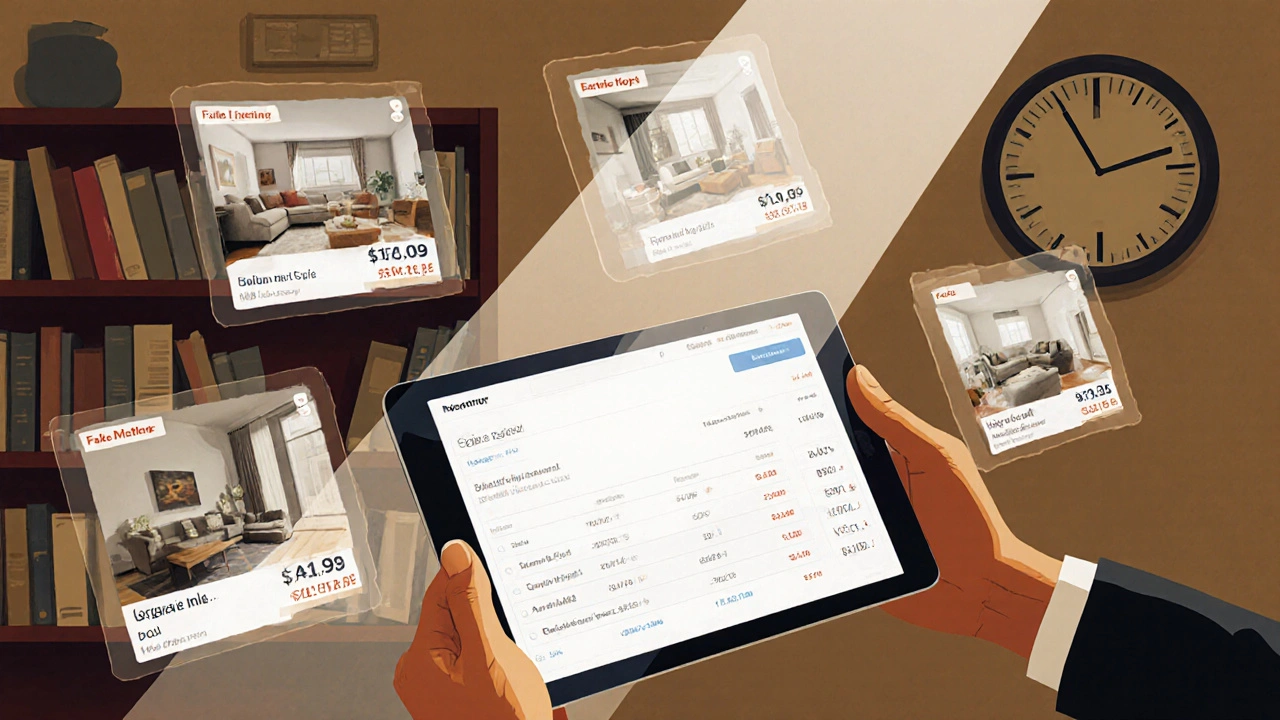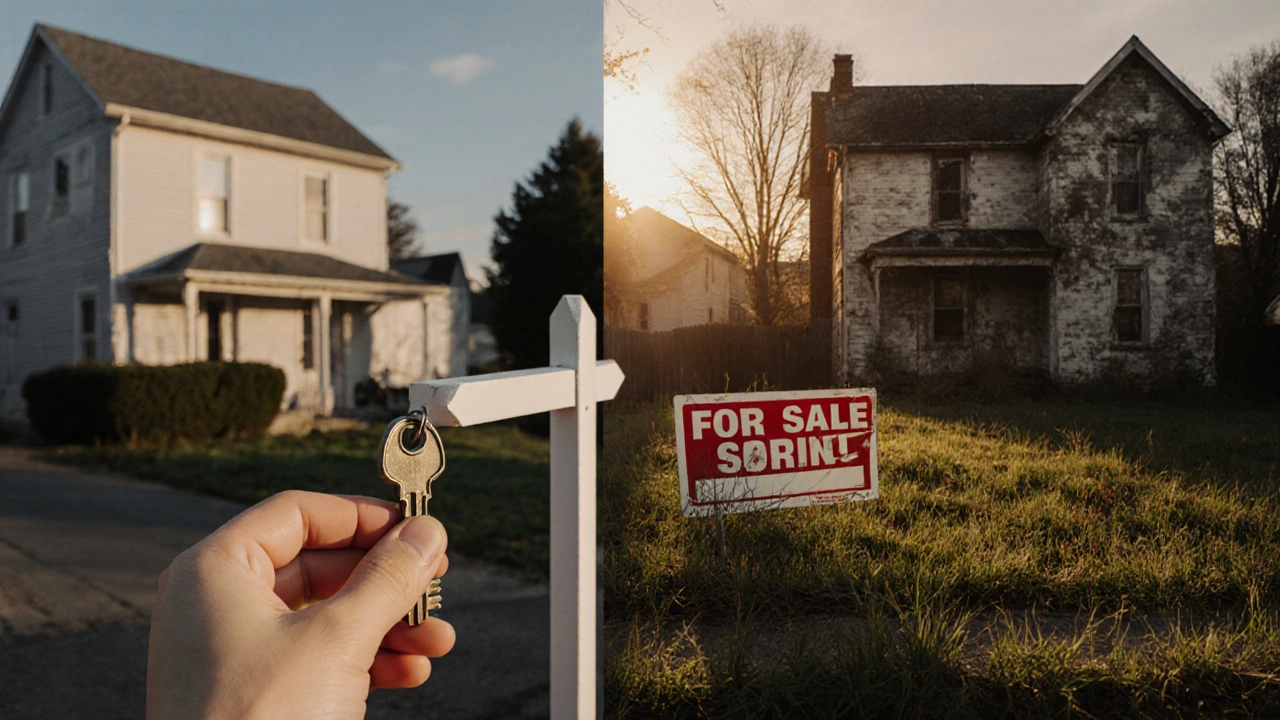Every day, thousands of people start their home search by typing "real estate listings" into a search bar. They expect to see homes that match their budget, location, and needs. But what they actually find? A mess of outdated listings, fake photos, and listings that vanished weeks ago. The truth? Most real estate listings online are broken in some way. And if you don’t know how to read between the lines, you’ll waste months-or end up paying way too much.
Why Most Real Estate Listings Are Misleading
Real estate listings aren’t like Amazon product pages. There’s no guarantee the price is accurate, the photos are real, or the home is even still available. In Austin, I’ve seen listings stay online for 90 days after the house sold. Why? Because some agents don’t update the system. Others intentionally keep old listings alive to drive traffic to their website.
And the photos? Don’t trust them. A 1,200-square-foot home can look like a mansion with wide-angle lenses, staged furniture, and bright lighting. I once looked at a listing that showed a "spacious backyard"-turns out it was a 12-foot-wide strip between two fences, with a single shrub and a broken swing set.
Then there’s the price. Some sellers list their home at $450,000 hoping to get $500,000. Others drop the price to $380,000 after three months, but the listing still says $450,000. You won’t know unless you dig deeper.
Where to Find Real Estate Listings That Actually Work
The best real estate listings come from the Multiple Listing Service, or MLS. That’s the database realtors use to share property details. But you can’t access it directly. You need a licensed agent.
Here’s the catch: not all agents are equal. Some use MLS only to show you what their office has. Others use it to show you everything in the market-even homes not listed by their firm. Ask any agent: "Can you pull up every active listing in [your neighborhood], not just the ones you listed?" If they hesitate, find someone else.
Public sites like Zillow, Redfin, and Realtor.com pull data from MLS-but they’re slow. A home can go under contract on MLS at 2 p.m., but it might still show as "active" on Zillow until midnight. That’s why you’ll call about a house, only to find out it’s already sold.
Here’s what works: get a local agent who checks MLS daily and sends you new listings the same day they hit the system. Don’t wait for emails. Set up alerts, but don’t rely on them. Real time matters.
How to Spot a Fake or Stale Listing
Here’s a simple checklist to avoid wasting your time:
- Check the listing date. If it’s older than 14 days and hasn’t had a price drop, it’s likely overpriced or has issues.
- Look for the number of photos. Listings with fewer than 8 photos are usually low-effort. Legit sellers show the kitchen, bathrooms, backyard, garage, and even the basement.
- Search the address on Google Maps. Street view can tell you if the house looks like the photos. If the yard in the listing looks lush but street view shows dry grass and cracked pavement, something’s off.
- Check the days on market. If it’s been listed for 60+ days, ask why. Is the roof leaking? Is the neighborhood declining? Is the seller unrealistic?
- Call the agent. Ask: "Is this home still available?" If they say "I think so," walk away.
I once spent two weeks chasing a listing that turned out to be a rental. The agent didn’t even know it was rented. That’s how sloppy things get.

What to Look for Beyond the Listing
A real estate listing gives you the basics: price, bedrooms, square footage. But it doesn’t tell you about the neighbors, the school district, or whether the water pressure drops when someone flushes the toilet.
Here’s what you need to dig into:
- Property tax history. Go to your county’s appraisal district website. If taxes jumped 30% last year, the home might be reassessed-and your costs will too.
- Neighborhood crime stats. Use sites like SpotCrime or local police dashboards. Don’t trust Zillow’s "safety score." It’s a guess.
- Utility costs. Ask the seller for the last 12 months of electric, water, and gas bills. A $400 monthly electric bill in summer? That’s a sign of bad insulation or an old AC.
- HOA rules. If it’s a condo or townhome, get the HOA documents. Some ban short-term rentals, pets, or even paint colors.
One buyer in South Austin fell in love with a house-until they found out the HOA charged $200/month and didn’t allow dogs. They lost their deposit. Don’t be that person.
How to Act Fast When You Find the Right One
The best homes don’t sit around. In Austin, a well-priced home in a good neighborhood often gets 3-5 offers in the first week. If you wait to "think it over," you’ll lose it.
Here’s how to move fast:
- Get pre-approved. Not pre-qualified. Pre-approved means a lender checked your income, credit, and debt-and gave you a written letter. Sellers only take serious buyers seriously.
- Have your agent ready. Don’t wait to find an agent after you see a house. Have one on speed dial. The best agents respond within 15 minutes.
- Know your max. Decide your top price before you start looking. Don’t let emotion push you over it. Walk away if it’s $5,000 over your limit.
- Be ready to offer. If you love it, make an offer the same day. Include a strong earnest money deposit. It shows you’re serious.
One client of mine saw a house at 8 a.m., toured it at 10 a.m., and had an offer in by noon. It sold that afternoon. She didn’t wait. She didn’t second-guess. She acted.

Red Flags That Mean Walk Away
Some listings are traps. Here’s what to watch for:
- "Seller will finance." That’s not a benefit-it’s a warning. Banks won’t lend because the house probably has serious problems.
- "As-is, no inspections." That’s how you end up with a $100,000 repair bill after closing.
- Photos with no people, no clutter. Over-staged homes hide flaws. Real homes have lived-in details. If it looks like a showroom, be suspicious.
- Agent won’t let you talk to the seller. If the agent refuses to connect you with the owner, they might be hiding something.
- Listing says "move-in ready" but has no recent renovation dates. That’s marketing speak. Ask for receipts for new HVAC, roof, or windows.
I once worked with a buyer who ignored all this. The house looked perfect. The price was too good. The agent was pushy. They bought it. Two weeks later, the foundation cracked. The seller had never disclosed the water damage. The buyer lost $60,000.
What to Do If You Can’t Find Anything
Some months, there just aren’t enough listings. That’s normal. But that doesn’t mean you give up.
Instead, try this:
- Look for expired listings. These are homes that didn’t sell. The sellers are frustrated. They might drop the price or accept an offer faster.
- Check for FSBO (For Sale By Owner). These aren’t on MLS, but they’re on Facebook Marketplace, Craigslist, or local community boards. You can save on commission-but be careful. No agent means no legal protection.
- Ask neighbors. Knock on doors in your target neighborhood. Ask: "Anybody selling?" You’ll hear about homes before they hit the market.
- Wait for seasonal dips. Homes sell slower in winter. More inventory, less competition. January and February are quiet months-but better deals.
One buyer in East Austin waited until January. She found a home that had been on the market for 112 days. The seller took $30,000 less than the original price. She got a new roof, updated plumbing, and a 30-year mortgage-all for under $320,000.
Final Tip: Don’t Trust the Website. Trust the Person.
Real estate listings are just data. The real value is in the person helping you use them.
Find an agent who:
- Responds within an hour, not a day
- Shows you listings you didn’t ask for because they know your taste
- Tells you when a house is a bad deal-even if it’s in your favorite neighborhood
- Has sold at least 15 homes in your target area in the last year
The right agent will save you more money than any discount or deal. They’ll help you avoid the traps. They’ll tell you when to walk away.
Real estate listings aren’t the destination. They’re the starting point. The real work happens after you click "view details."
Are Zillow and Redfin reliable for real estate listings?
Zillow and Redfin are useful for getting a general idea, but they’re not reliable for real-time accuracy. Listings can stay online for days after a home sells. Prices often lag behind actual market changes. Always verify with a local agent who pulls directly from the MLS. Don’t make offers based on what you see on these sites alone.
Why do some homes stay on the market for months?
Homes that sit for months are usually overpriced, have hidden issues, or are in declining neighborhoods. Sometimes, the seller is unrealistic about value. Other times, the home has structural problems, a bad floor plan, or an unappealing location. Ask for the property’s full disclosure statement and check tax records to see if the value dropped recently.
Can I buy a home without a real estate agent?
Yes, but it’s risky. You’ll need to handle inspections, contracts, financing, and closing paperwork yourself. You also won’t have access to MLS data unless you’re licensed. FSBO (For Sale By Owner) homes are your best bet if you’re going solo-but always hire a lawyer or title company to review the contract. Most buyers save money by using an agent, even if the seller pays their fee.
How do I know if a listing is a scam?
Red flags include: no verifiable agent contact info, requests for wire transfers before viewing, photos that don’t match the address on Google Street View, and pressure to pay a "holding deposit" quickly. Legit sellers never ask for money upfront. Always insist on a physical tour before writing a check. If it feels too good to be true, it is.
Should I look at homes in person or rely on virtual tours?
Virtual tours are great for narrowing options, but never buy based on them alone. Lighting, noise, smells, and neighborhood energy don’t show up in videos. Walk around the block at different times. Listen for traffic, planes, or barking dogs. Check the condition of nearby homes. These details make or break a purchase-and you can’t see them online.

12 Responses
Let’s be real-Zillow is a marketing scam wrapped in a data layer. The algorithm doesn’t care if your dream home sold three weeks ago; it just wants you to click and stay on the page. I’ve lost count of how many times I’ve scheduled showings for listings that vanished before I even got out of my car. If you’re not working with an agent who has direct MLS access, you’re just playing Russian roulette with your down payment.
And don’t get me started on the staging. A $12,000 sectional sofa in a 700-square-foot living room? That’s not interior design. That’s psychological warfare.
Real estate isn’t about listings. It’s about access. And access is controlled by who you know, not what the website says.
THEY’RE ALL FAKE. EVERY SINGLE ONE. THE GOVERNMENT AND BIG REAL ESTATE ARE IN BED TOGETHER. THEY WANT YOU TO THINK YOU’RE BUYING A HOUSE BUT REALLY YOU’RE BUYING A DEBT TRAP. THEY USE PHOTOS TO MAKE YOU CRAZY THEN THEY SELL YOU A HOUSE WITH MOLD IN THE WALLS AND THE AGENT GETS A BONUS. I SAW A VIDEO ON 4CHAN WHERE THEY ADDED DIGITAL TREES TO BACKYARDS. THEY’RE LYING TO YOU.
THEY’RE WATCHING YOU RIGHT NOW. DON’T CLICK ANYTHING.
You think this is about listings? No. This is about control. The MLS is a cartel. The agents are gatekeepers. The government allows it because they profit from property taxes. You think Zillow’s algorithm is neutral? It’s coded by people who own shares in title companies. They inflate prices so you borrow more so they can sell you insurance so they can securitize your mortgage so they can sell it to China. You’re not buying a house. You’re buying into a financial pyramid.
And the worst part? You’re not even supposed to know this. That’s why they call it ‘real estate’-to make you think it’s real. It’s not. It’s a simulation. And you’re the NPC.
It is, in fact, a profoundly regressive and structurally inequitable system we have normalized under the guise of ‘the American Dream.’ The very architecture of real estate listings-dependent as it is upon proprietary databases, opaque pricing mechanisms, and algorithmic obfuscation-functions as a gatekeeping apparatus that systematically excludes those without social capital, financial literacy, or institutional access.
One cannot reasonably expect an individual without a licensed intermediary to navigate a labyrinth designed by lawyers, data brokers, and marketing departments whose incentives are fundamentally misaligned with the buyer’s welfare. The notion that one might ‘do it themselves’ is not merely naive-it is a form of economic self-harm, perpetuated by the very platforms that profit from your ignorance.
And yet, we glorify the ‘self-made’ buyer, when in truth, the only self-made thing here is the illusion of autonomy.
Pre-approved is everything. No exceptions.
Agent matters more than the house.
You think the seller is the one lying? No. The system is lying. The listing is just a symptom. The real lie is that you can own anything. Houses are just leases with higher payments. The land belongs to the state. The deed is a contract you didn’t read. The taxes are a fee for the privilege of existing on dirt.
You think you’re buying a home? You’re buying a lien. The only real freedom is walking away.
And yet you keep clicking. That’s the real scam.
Man I just got my first offer in on a place last week. Had the agent on speed dial. Got the pre-approval letter before I even started looking. Made the offer same day. Didn’t even sleep on it.
Turned out the house had a weird smell in the basement. Turned out it was just the previous owner’s dog. We got it cleaned and now it’s perfect.
Point is: move fast, but stay chill. Don’t let the hype make you dumb.
OMG YES I DID THIS LAST YEAR AND I WAS SO SCARED BUT I JUST WENT FOR IT AND GOT A HOUSE FOR 30K UNDER LISTING BECAUSE THE SELLER WAS TIRED OF WAITING
AND I MET THE NEIGHBOR WHO TOLD ME THE HOUSE HAD A NEW ROOF LAST YEAR AND THE KITCHEN WAS RENOVATED IN 2022 SO I DIDNT TRUST ZILLOW AT ALL
JUST KNOCK ON DOORS AND ASK IF ANYONE’S SELLING I SWEAR IT WORKS
AND IF YOU FEEL LIKE YOU’RE BEING PUSHED WALK AWAY I DID THAT TOO AND I GOT A BETTER HOUSE LATER
YOU GOT THIS :)
How can anyone still trust these platforms? They’re not just unreliable-they’re morally bankrupt. They commodify human shelter. They turn homes into speculative assets. They encourage greed disguised as aspiration. And you? You’re complicit. You click. You scroll. You dream. You pay. You lose. You cry. You blame yourself. But the system? It just keeps running. And it’s laughing.
There is no ‘right property.’ There is only survival. And you’re not surviving-you’re being harvested.
USA real estate is getting destroyed by foreigners and illegal aliens. They’re buying up houses with cash and flipping them. Then the prices go up and real Americans can’t afford anything. I saw a listing in Texas with a Chinese name as the owner. That’s not America anymore.
Get your agent to check the buyer’s background. If they’re not a U.S. citizen, walk away. This isn’t just about money-it’s about sovereignty.
People who say ‘just hire an agent’ are the same people who think ignorance is a virtue. You don’t need an agent. You need to educate yourself. MLS data is public. You can access it through FOIA requests. You can pull tax records. You can hire a home inspector before you even look. But no-you’d rather let someone else do the work while you cry about scams.
Stop being lazy. Stop being gullible. Stop letting agents profit from your incompetence.
Just want to say this post was super helpful. I was about to make a dumb offer on a place that looked great online but had no photos of the kitchen. Then I checked street view and the roof looked like it was held together with duct tape. Called the agent, asked if it was still available, and they said ‘actually sold yesterday.’
Thanks for the checklist. I’m gonna use it next time.
Also, honey, you’re right about knocking on doors. I did that last week and found a place that wasn’t listed anywhere. Owner was just tired of dealing with renters. We’re closing next week.